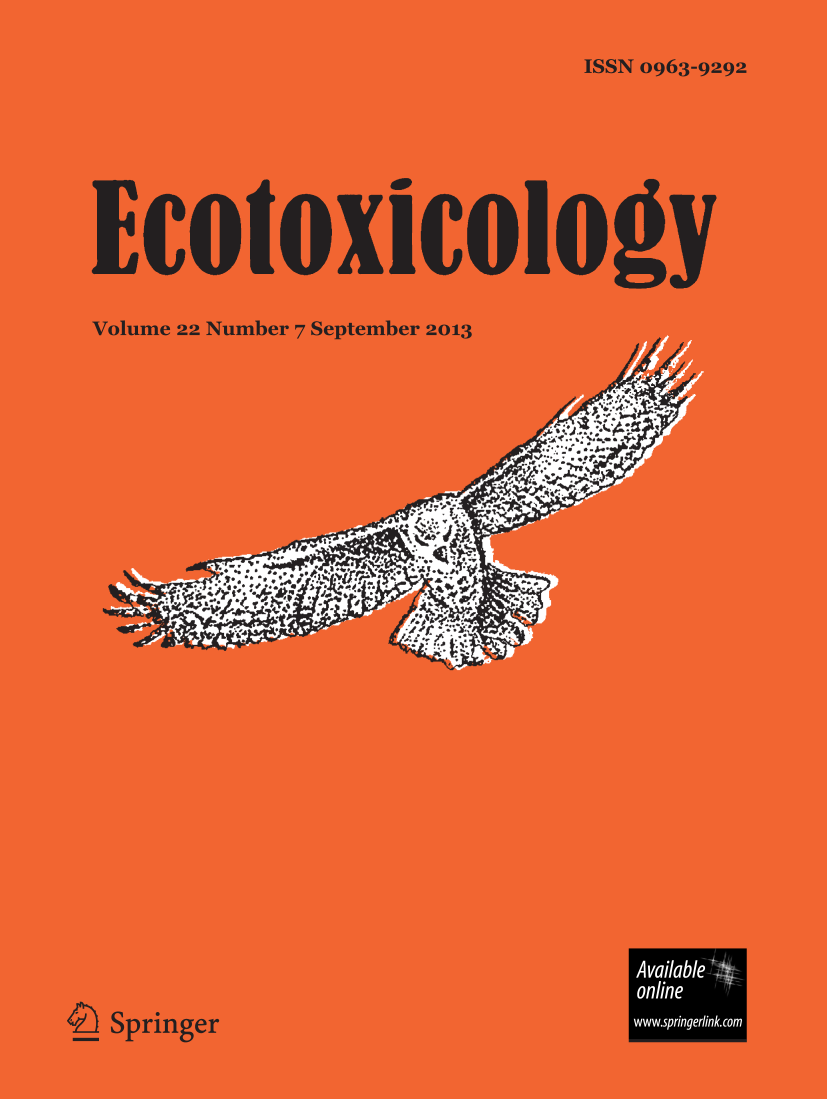下载PDF
{"title":"除草剂配方和扩散剂对大黄蜂喷雾和接触后存活率的影响。","authors":"Ryleigh V Gelles, Thomas S Davis","doi":"10.1007/s10646-025-02876-x","DOIUrl":null,"url":null,"abstract":"<p><p>Surfactants are often included as co-formulants in the application of herbicides to aid in spreading and adherence to plant surfaces, but toxicity to native bees has not been extensively tested. In a set of progressive experiments, we evaluated effects of products containing glyphosate and spreading agents, as well as spreading agents alone, on bumblebees (Bombus impatiens Cresson) using parametric survival analysis. We test spreaders from multiple chemical classes including Silwet L-77© (trisiloxane), Alligare 90© (polyoxyethylene), and Southern Ag SA-50© (C10-16 alcohols). We report low lethality of high-glyphosate herbicide formulations (Rodeo©), but bee mortality increased ~20% with addition of a silicone-based spreading agent (Silwet L-77©). Spreaders alone strongly affected bee survival: effects were concentration-specific and did not differ depending on exposure method (spray application vs. application to surfaces contacted by bees). The widely used trisiloxane-based spreader Silwet L-77© was especially hazardous, and exposure to high concentrations of Silwet L-77© caused rapid and near-total mortality in B. impatiens. Analysis of whole-bee cuticle extracts after exposure revealed clear differences in the cuticular hydrocarbon profiles associated with exposure to spreading agents: the alkane n-hexacosane was present in all extracts but was detected in greater relative abundance from bees exposed to Silwet L-77© and Alligare 90©. To support wild bee conservation efforts, we recommend substituting alcohol-based spreaders for siloxane-based spreaders when possible. In addition, certain cuticular hydrocarbons may be useful as biomarkers of previous exposure to certain surfactants, which can aid investigations evaluating causes of bumblebee decline across landscapes.</p>","PeriodicalId":11497,"journal":{"name":"Ecotoxicology","volume":" ","pages":"736-745"},"PeriodicalIF":2.7000,"publicationDate":"2025-07-01","publicationTypes":"Journal Article","fieldsOfStudy":null,"isOpenAccess":false,"openAccessPdf":"https://www.ncbi.nlm.nih.gov/pmc/articles/PMC12254061/pdf/","citationCount":"0","resultStr":"{\"title\":\"Evaluation of herbicide formulations and spreading agents on survival of the bumblebee Bombus impatiens following spray and contact exposure.\",\"authors\":\"Ryleigh V Gelles, Thomas S Davis\",\"doi\":\"10.1007/s10646-025-02876-x\",\"DOIUrl\":null,\"url\":null,\"abstract\":\"<p><p>Surfactants are often included as co-formulants in the application of herbicides to aid in spreading and adherence to plant surfaces, but toxicity to native bees has not been extensively tested. In a set of progressive experiments, we evaluated effects of products containing glyphosate and spreading agents, as well as spreading agents alone, on bumblebees (Bombus impatiens Cresson) using parametric survival analysis. We test spreaders from multiple chemical classes including Silwet L-77© (trisiloxane), Alligare 90© (polyoxyethylene), and Southern Ag SA-50© (C10-16 alcohols). We report low lethality of high-glyphosate herbicide formulations (Rodeo©), but bee mortality increased ~20% with addition of a silicone-based spreading agent (Silwet L-77©). Spreaders alone strongly affected bee survival: effects were concentration-specific and did not differ depending on exposure method (spray application vs. application to surfaces contacted by bees). The widely used trisiloxane-based spreader Silwet L-77© was especially hazardous, and exposure to high concentrations of Silwet L-77© caused rapid and near-total mortality in B. impatiens. Analysis of whole-bee cuticle extracts after exposure revealed clear differences in the cuticular hydrocarbon profiles associated with exposure to spreading agents: the alkane n-hexacosane was present in all extracts but was detected in greater relative abundance from bees exposed to Silwet L-77© and Alligare 90©. To support wild bee conservation efforts, we recommend substituting alcohol-based spreaders for siloxane-based spreaders when possible. In addition, certain cuticular hydrocarbons may be useful as biomarkers of previous exposure to certain surfactants, which can aid investigations evaluating causes of bumblebee decline across landscapes.</p>\",\"PeriodicalId\":11497,\"journal\":{\"name\":\"Ecotoxicology\",\"volume\":\" \",\"pages\":\"736-745\"},\"PeriodicalIF\":2.7000,\"publicationDate\":\"2025-07-01\",\"publicationTypes\":\"Journal Article\",\"fieldsOfStudy\":null,\"isOpenAccess\":false,\"openAccessPdf\":\"https://www.ncbi.nlm.nih.gov/pmc/articles/PMC12254061/pdf/\",\"citationCount\":\"0\",\"resultStr\":null,\"platform\":\"Semanticscholar\",\"paperid\":null,\"PeriodicalName\":\"Ecotoxicology\",\"FirstCategoryId\":\"93\",\"ListUrlMain\":\"https://doi.org/10.1007/s10646-025-02876-x\",\"RegionNum\":4,\"RegionCategory\":\"环境科学与生态学\",\"ArticlePicture\":[],\"TitleCN\":null,\"AbstractTextCN\":null,\"PMCID\":null,\"EPubDate\":\"2025/3/18 0:00:00\",\"PubModel\":\"Epub\",\"JCR\":\"Q2\",\"JCRName\":\"ECOLOGY\",\"Score\":null,\"Total\":0}","platform":"Semanticscholar","paperid":null,"PeriodicalName":"Ecotoxicology","FirstCategoryId":"93","ListUrlMain":"https://doi.org/10.1007/s10646-025-02876-x","RegionNum":4,"RegionCategory":"环境科学与生态学","ArticlePicture":[],"TitleCN":null,"AbstractTextCN":null,"PMCID":null,"EPubDate":"2025/3/18 0:00:00","PubModel":"Epub","JCR":"Q2","JCRName":"ECOLOGY","Score":null,"Total":0}
引用次数: 0
引用
批量引用




 求助内容:
求助内容: 应助结果提醒方式:
应助结果提醒方式:


